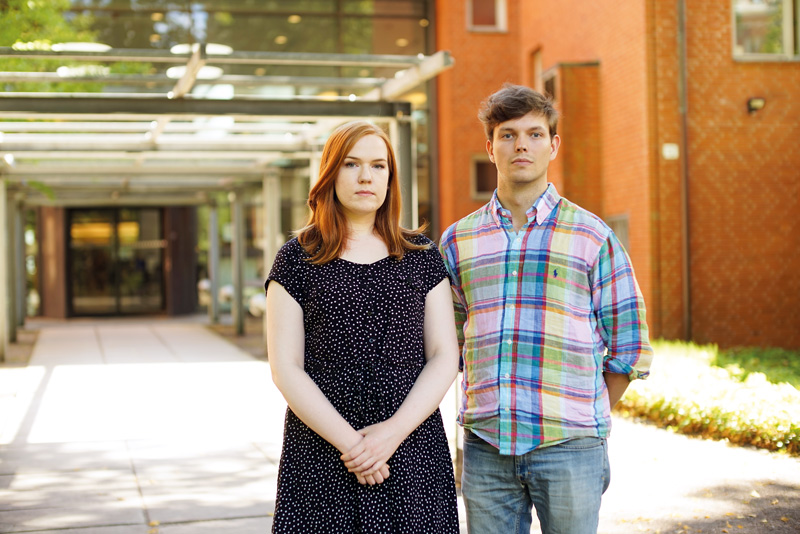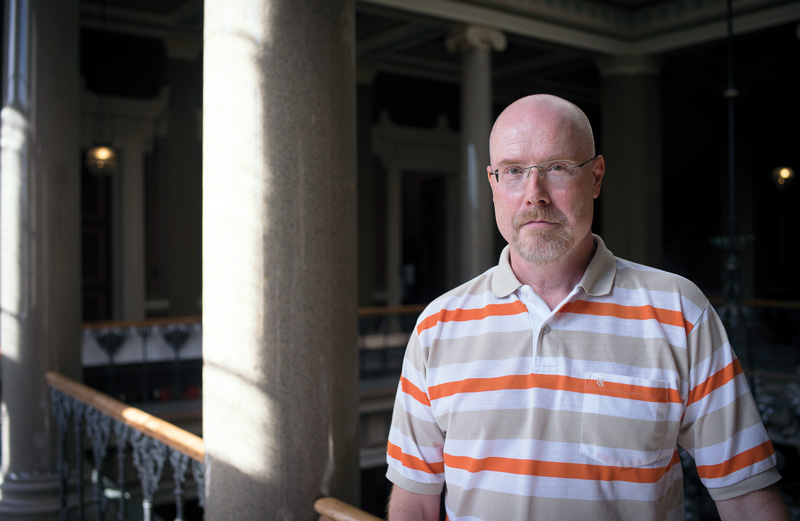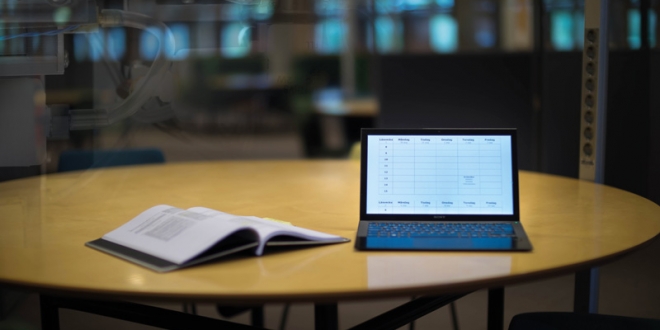Lack of resources results in Lund students having less and less in-class teaching. At the same time, the University and the government plan to spend huge sums on research. How does it all add up?
“In the first semester, we worked in groups of 15 students each. That did not work at all. The teachers said something like, ‘well, we know this is not a good solution, but due to budget strains, we have no other choice’”.
On a balcony in the west of Lund is Gottfrid Jansson. It is summer and the sun is shining. He is peering into his coffee cup.
When Gottfrid Jansson was enrolled in the basic course in Art History and Visual Studies, he had about ten hours of teacher-led classes a week. Later, in the Bachelor’s course, that amount decreased to around two hours a week.
“It felt like many students lost interest and had motivational problems due to the level of individual studies. A good lecture raises questions and sparks your curiosity. If you do not get enough of that, you might give up,” Gottfrid Jansson says.
Among Gottfrid’s things, there is a thick statute book with several colourful marking slips sticking out of it. After writing his Bachelor’s Thesis, Gottfrid Jansson chose to go down a different path. In spring 2016, instead of finishing his Bachelor’s Degree, he enrolled in the Law programme, and it is quite different compared with the courses in History of Arts.
“The number of techer-led hours are more numerous in this programme. We have teaching in some form almost every day – which I enjoy. Quite simply, I believe that you learn more, and you get more motivated,” he says.
Dated system for resource allocation
The number of teacher-led hours a regular student, like Gottfrid Jansson, can expect all depends on how much money the University can spend on a specific education programme.
The system deciding how much money each seat of learning receives from the state piggy-bank was initiated in the 1990s. The seats of learning are granted a certain sum for each student enlisted there, which is then re-calculated as the number of whole-year students, as well as another sum based on the number of passed courses in a year – a so called annual achievement.
The size of the appropriation can vary; someone studying technology, natural sciences, pharmacology, or healthcare generate almost twice as much money compared with a student enlisted in courses within the humanities and theology, social sciences, or law. Arts and crafts students generate the most.
“The size of the appropriation for different areas of education are based on calculations made in the 1990s. They are obsolete and should most definitely be re-estimated. A lot has happened since then,” says Daniel Kraft, vice-chairperson of the Student Union for the Humanities and Theology.
He gives an example taken from his own faculty:
“There is a view that humanists only need paper and pen. But actually, many of us make use of laboratories and field studies. The costs for education in these areas have changed,” he says.
When it comes to the Humanities, Social Sciences, Law, and Theology studies, where appropriations are the lowest, students’ schedules can look very sparse.
“We have conducted a survey that shows that the average theology or religion studies student only has about three and a half hours of teacher-led lecturing time a week,” says Amanda Bjernestedt, chairperson of the Student Union for the Humanities and Theology.

Greater revenues for research
In spite of the number of teacher-led lectures decreasing, and the size of study-groups increasing, all is not darkness at Swedish seats of learning. Basic courses might be struggling, but it seems to be a bit better for the other main part of Swedish universities: research and postgraduate education.
According to statistics from the Swedish Higher Education Authority (UKÄ), the combined revenues of Swedish seats of learning from research and postgraduate education were close to 40 billion SEK last year. The combined revenues coming from education on undergraduate and graduate-level, on the other hand, were a mere 27 billion SEK.
Additionally, the revenues of Swedish seats of learning generated from research and postgraduate education have increased by 31 percent between 2005 and 2015, whilst the corresponding increase for undergraduate programmes is only 8 percent.
The economic muscle of research can certainly be seen in Skåne and Lund. The ESS (European Spallation Source), a European research initative that began in 2014, is calculated to cost 1.8 billion EUR to build, on its own. Thirty-five percent of this cost is to be paid by Sweden. Sweden will also pay for ten percent of the costs for running the facilities, amounting to 140 million EUR annually. Lund University themselves have put in about 600 million SEK in the project.
Research to generate growth
However, no one pretends that Swedish research would be suffering from vanity and abundance. According to Mats Benner, professor of research policy at the Department of Business Administration at Lund University, there are still fundamental differences in what is required in education contra research.
“Undergraduate education is underfinanced. I would not say the same about research, although that area is not over financed either,” he says.
According to social democrat Lena Hallengren, chairperson of the parliamentary educational committee, the increase in appropriations in the last ten years is a result of the priorities in a research proposition presented by the conservative parties in 2008, among other things. At that time, appropriations were increased with five billion SEK during a five-year period; this was one of the biggest and most expensive reforms of the conservative government.
“The initiative was huge, but it did not include all kinds of research, being primarily focussed on high-level research and research in certain areas. The Swedish Social Democrats rather wish to increase the basic appropriations,” says Lena Hallengren.
The present government did suggest an increase in the basic appropriations in their budget proposition for 2016, in which 300 million SEK extra were allocated for basic appropriations for research. New funds were also allocated to higher education, not for raising appropriations but instead for creating even more places in courses.
The planning manager of Lund University, Tim Ekberg, believes that it could be easier for the Minister for Education to persuade the Minister of Finances, for example, to put money into research, rather than spend them on education.
“If the Minister of Education would want to increase research appropriations, the government can provide the reason of growth and GNP. Research create innovation, which creates companies and efficiency, which leads to job opportunities and economic growth. Initiatives in education, which are inherently more long-term, have been harder to lobby,” he says.

The USA prioritise education
How to prioritise between research and education can vary greatly between contries. The report Utbildning, forskning, samverkan. Vad kan svenska universitet lära av Stanford och Berkeley? (2014), co-written by Mats Benner, puts forth the argument that the one-sided focus of Swedish seats of learning on research is one of the greatest weaknesses in relation to the American high-prestige seats of learning.
According to the authors, the research-focus might be a result of the fact that, in Sweden, success in academia is seen as on par with success within research, which results in education being disregarded. But there are also economic differences between Swedish and American seats of learning.
“At Stanford and Berkeley, educational work is a far greater part of the budget of the seats of learning than it is in Sweden,” Mats Benner says.
However, he believes that is would take a lot more than just money to re-elevate the status of basic programmes in Sweden. For example, reforms concerning how academics are recruited, and how lecturers can control their lectures are needed as well. If the present attitude towards undergraduate education does not change, not only will students be affected, researchers will as well.
“If the link between research and education is broken, research becomes sterile. If undergraduate education loses its connection to research, it will affect research quality in the long-term as well,” according to Mats Benner.
The University want to allocate themselves
When the Vice-Chanchellor of Lund University, Torbjörn von Schantz, took his position last year, he said in an interview with Lundagård that increased resources for undergraduate education was the issue closest to his heart.
Since then, not much has happened.
But in the budget material from the University concerning 2016 sent to the government, the Board suggested that the seats of learning should allocate appropriation funds between eduaction and research themselves. Today, money is already earmarked by the government when the universities receive it, which the University Board think makes the linking of research and education harder.
Sven Stafström, director-general of the Swedish Research Council, is hesitant towards the suggestion.
“On the one hand, seats of learning will experience more flexibility. On the other, there is a risk that priorities will become slop-sided to one or the other. It is important to maintain a balance between research and education on a national level,” he says.
Question of re-allocation divides
Another possible way of improving the conditions for the Humanities as well as other low-resource educational areas would be for the University to re-allocate funds from education programmes with greater financial strength. That is how some other seats of learning solve the issue.
“In Uppsala, funds have been re-allocated to, among other things, language studies, which had become severely underfinancied otherwise. I do not understand why we cannot do that in Lund as well,” says Anna Bjernestedt, chairperson of the Student Union for Humanities and Theology.
But actually, a similar system was used in Lund up until the year 2010. In that year, it was removed because the departments thought resource allocation had become unpredictable.
Initiating a new re-allocation system is very much possible, but it would entail that the University Board and all department come to an agreement.
“Personally, I think that the model used in Uppsala is interesting. But the departments should agree on initiating it – including those who are then going to lose funds. That could prove hard, and might be the reason why the issue has not been discussed in the last few years,” Tim Ekberg says.
Hurts public image
If undergraduate appropriations are to be increased, or the allocation system is to be revised, a governmental decree is needed. But those might be hard to get. This is something Tim Ekberg is well aware of since he worked at the Ministry of Education and Research for ten years, adhering to five different Ministers of Education. All of the ministers wanted to increase resources to undergraduate education, but none of them were able to make it happen.
“It could be tough standing up to the Ministry of Finances, who are in charge of budgeting; each ministry wants money put into its own area. Furthermore, increases in student places in courses tend to generate better press than increases in appropriations. It is a bit easier for the public to grasp, which gives positive political points,” Tim Ekberg says.
Since resource allocation is a political issue, Lund University cannot do that much to check the underfinancing, apart from trying to influence the government.
“Lund University, together with every other seat of learning nag and nag about more funds, and that the allocation system should be redefined. That is the way it has been for the last 20 years, but in the end, it is still the politicians who decide,” Tim Ekberg says.
Prepared for both?
Like most universities with long standing traditions, Lund University has its own motto given in Latin: “Ad utrumque”, usually translated as “prepared for both”.
At first, the phrasing alluded to Lund students being prepared not only to study, but also to violently fend off Danes and other unwelcomed people from the then newly acquired Skåne. As time has progessed, “prepared for both” has acquired a new meaning, in the light of the dual purpose of universities today: education and research.
The fact that the biggest research facilities in Sweden are about to be inaugurated in Lund sends a clear message – the University are prepared for research.
But are they prepared to give students a solid educational ground to stand on? And maybe even putting research on the back-burner, if required?
As an employee, Tim Ekberg must remain neutral. But he has previously been chairperson of a Student Union, and has been involved in educational issues, not least concerning humanities and theology.
“Part of me probably still wants to see increased appropriations and a re-allocation of funds. If I were to be a student today, I would be dissatisfied with how research is prioritised, while education is put on the back burner,” Tim Ekberg says.
Text: Oscar Madunic Olsson
Translation: Richard Helander






